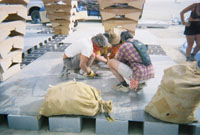
Pagoda of Infinite Reflection
Pagoda Home: Let's make a big mid-week FIRE!
EVENT:NEW! [Todd][Waldemar ! ][Others] Pre-EVENT:[funding][Pre-Compression Raffle][how it started][who we are][early concepts][early concepts 2][prototype building][final design][PROJECT PLAN][1st burn: Arthur][1st burn: Wizzard][1st burn: Dr. Wow][budget & parts list][movies][lighting][final design 2][emails][flambe][into summer][logistics][survival]
Team Members:[Arthur Z][Buck][Dea][Debi][Dr. Wow][Gerry][Jill][Marcel][Paris][Wizzard]
[Movies][burner stickers]
Lesson Learned: [Burn Platform][Playing Cards]
Event Photos: Burn Platform
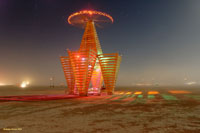
[med][big]
Pagoda Night
© 2004 Waldemar Horwat
[waldemar's site]
On Thursday at midnight it turned into a good old-fashioned burn; it burned for longer than the Man or the Temple, and will never be seen again.
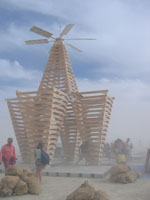
[med][big]
Platform nearly done
24 ft square, and built of steel sheets over spaced-out cinder blocks, the platform design had several good points.
- It was installed by volunteers wearing work gloves. The only tools needed are a measuring string and a cordless drill (though a DPW Hyster helped in advance, by moving heavy materials to the site.) Installation time was about four hours for an average of six workers; this can surely be improved on.
- It need not be installed early; it can be installed just before the burn. (More on this below.)
- It provided excellent protection. During the 12-hour hardwood burn, the 8" air passageways under the steel conducted heated air away. Late-night visitors enjoyed sitting on the platforms' edge, where their feet were bathed in warm air. When we dismantled it, we found the playa beneath clean and untouched by heat.
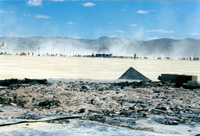
[med][big]
Ash Pile After the fire
- Following a burn, it is easy to clean with a shovel, broom, and dustpan.
- It is immediately reusable! We cleaned it Friday afternoon, and by Friday night another art piece was moved onto it and conflagrated.
- It is recyclable. The steel sheets acquired artful warps and rainbow patinas but were fully reusable. Nearly all the cinder blocks survived; a few had cracks. (More on this below.) We donated them to the DPW, who have stored them for future use.
- The materials are expensive, but comparable to the cost of sand and a kevlar blanket.
- The materials are heavy.
- Attention to safety is a necessity. The blocks are rough and weigh nearly 40 pounds. Steel sheet has a wickedly sharp edge.
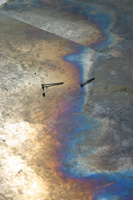
[med]
'artful warps and rainbow patinas'
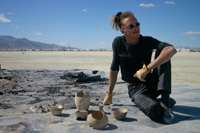
[med]
A potter who placed his pots at the base of the fire and a nearly clean platform.
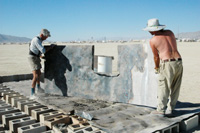
[med][big]
Carrying it away
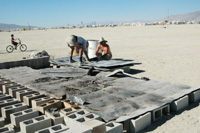
[med][big]
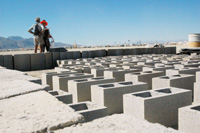
[med][big]
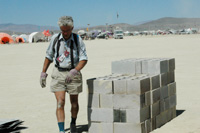
[med][big]
Ember Stacking Blocks
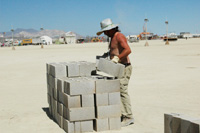
[med][big]
Thanks Marcel!
What's wrong with these pictures?
A:
No pallets under theblocks! DPW needs the pallets for hauling, but we had burned ours.
Sigh.
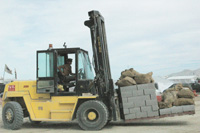
[med][big]
- 24-gauge ungalvanized steel, in 4ft x 10ft sheets. Our supplier: Serra Corporation, Grass Valley, CA. Contact: Ian MacMillen, Ianm@Serragold.com. Cost: about $450.00 for 18 sheets 24 ga cold rolled steel 48" x 120". Unit cost was .62/lb, 40 lbs per sheet, 720 lbs total, and one of the team hauled it out to the playa. Do not use galvanized steel. Burning it releases zinc oxide, a pollutant that can cause zinc fume fever.
- cinder blocks (in Nevada, called "standard blocks") 8in x 8in x 16in. Our supplier: Kent's Supply Center in Fernley, phone (775) 835-6100 . Cost: $1.58 per block, plus shipping charges of $1.80 per one-way mile. (90 miles to BRC; or haul them yourself.) Their truck carries its own fork-lift for unloading pallets of blocks.
- self-tapping sheet metal screws. Make sure they're steel, and will stick to a magnet.
- cordless drill, magnetic hex socket bit for sheet metal screws
- leather gloves
- protective footwear
- (maybe) metal snips
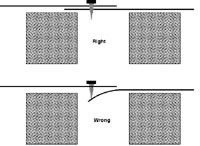
[med]
right and wrong
The key requirement is that edges of steel sheets must land on blocks. An unsupported edge is almost impossible to screw into -- it just bends out of the way. [see: right and wrong]
At the edge of the platform, blocks should project beyond the steel edge, to reduce the risk of leg-cut accidents. We positioned blocks to get a repeat every 44in. in one direction and every 116in. in the other. (That's 4" less than sheet size, to allow for overlapping.) Pre-playa, we calculated the spacing and prepared measuring strings marked with blue tape for positioning the blocks. [see: String Picture below]
Blocks are delivered on pallets. Save the pallets! Don't let them burn! You will need them later, to restack used blocks on so they can be moved by DPW's forklift.
To economize on materials, we did some cutting of steel sheets. This is hard work that should be left to an experienced metalworker with left- and right-handed metal snips. Consider overlapping sheets rather than cutting to fit. Intact sheets will be more useful when recycled.
We screwed sheets together near corners and at the middle of the long sides. Doubling this, to fasten every two feet, makes the sheet assembly strong enough to support extra heavy loads (such as the collapse of a heavy structure).
We're considering two changes in our next platform. First, space blocks closely around the platform edge, where gaps are particularly unstable and tricky to walk on. It's likely that we could use wider spacing in the center, where sheets are screwed to neighboring sheets. Second, try rotating blocks so the holes are horizontal. There's a strength loss, but a gain in airflow cooling. We'd also like to try out 26-gauge sheet steel. It's lighter and less expensive, but it might not be sturdy enough.
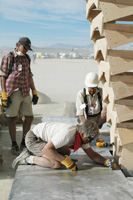
[med][big]
Fitting metal around the feet.
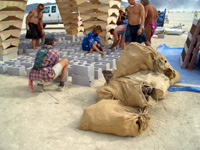
[med][big]
String Picture. Blow up and look near near woman in blue and to left of nearest worker
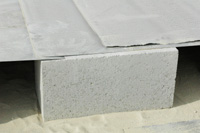
[med][big]
Blocks and metal near an edge
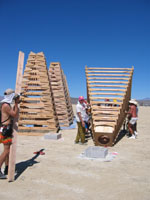
[med][big]
The pagoda feet were placed on sand filled blocks. The remainder of the protection was still in the future.
You may want your art to rest on empty playa, inviting visitors to stroll close and hang out -- a burn platform is pretty uninviting to walk or sit on. If you erect your art on a few steel-protected cinder blocks, you can enjoy empty playa through the week and install the full platform the day before your burn.
We erected the Pagoda on four cinderblock pads. Each pad was a tight group of blocks, with sand filling the holes in the blocks, and no steel covering the pad. [see: pagoda feet] This turned out to be a mistake. Without air circulation and steel protection, the pads and the playa beneath them got much hotter. The playa was discolored (slightly) and some pad blocks cracked. And, removing the sand was the heaviest part of our cleanup.
Because the pads had no steel on them, we screwed the nearest sheets to the Pagoda's wooden feet. This also turned out to be a mistake. It provided no protection, and when the structure collapsed it tried to pull up the attached steel with it. [see: bent metal]
If you install your platform in advance, make sure your structure will rest on blocks, not on gaps between blocks.
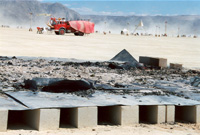
[med][big]
Bent metal
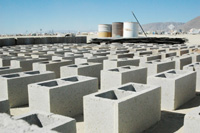
[med][big]
Blocks after the fire.
Cinder blocks have a relatively high water content, and will not stand up to severe heating. Our blocks that were protected by steel, and spaced to allow airflow, survived a long hot fire. Of those under the Pagoda feet that were unprotected by steel , some survived apparently intact and others cracked (but could still support weight). Interestingly, the following night someone moved three or four blocks to form a windbreak for a small fire, and the flames were in contact with the blocks. These blocks disintegrated.
Other relevant photos:
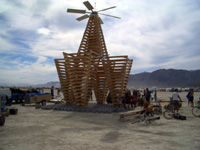
[med][big]
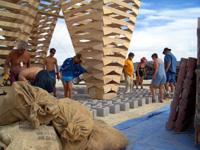
[med][big]
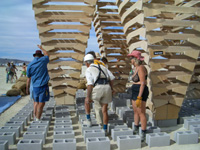
[med][big]
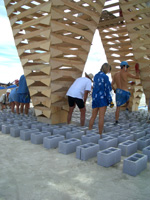
[med][big]
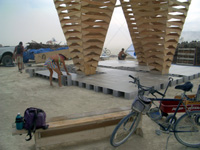
[med][big]
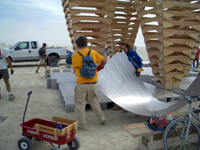
[med][big]
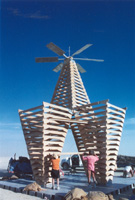
[med][big]
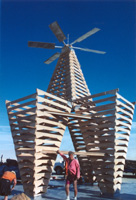
[med][big]
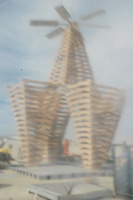
[med][big]
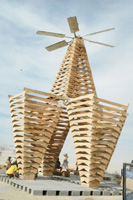
[med][big]
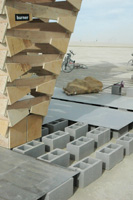
[med][big]
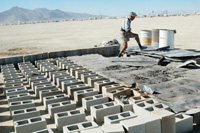
[med][big]
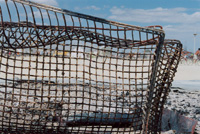
[med][big]
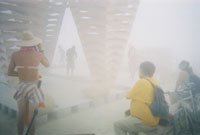
[med][big]
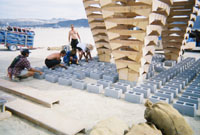
[med][big]
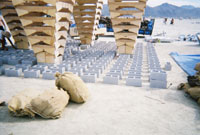
[med][big]
